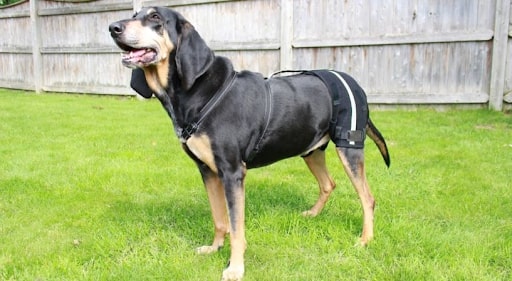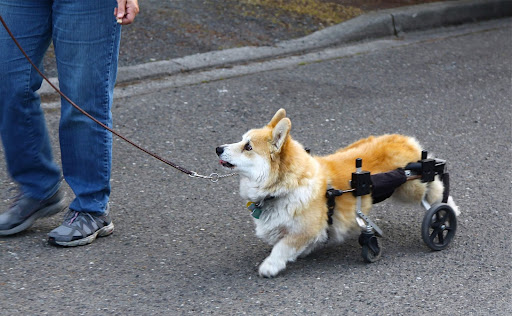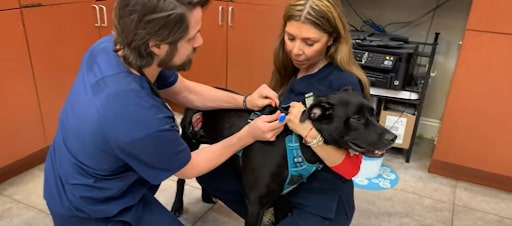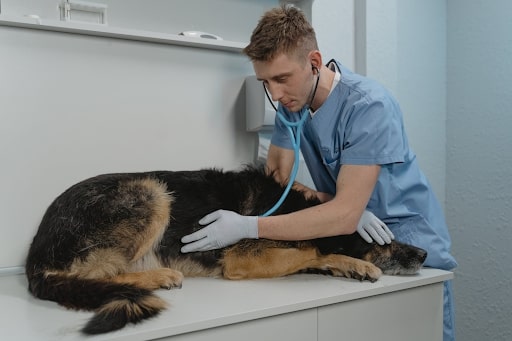Hip dysplasia is a common condition among dogs, with 18.2% of dogs showing signs of the socket in the hip joint not covering the ball properly. In the worst scenario, the solution is hip replacement surgery. Additionally, dogs may suffer from severe arthritis, for which hip replacement might be the answer.
Fractures and dislocations can also call for this type of surgery. The average cost of hip replacement is $3,500-7,000. However, total hip replacement (THR) surgery costs can depend on various factors like pre-operative tests and post-surgery care.
Find out more about the overall cost of hip replacement surgery and how to reduce the overall expenses.
Factors that Influence the Cost of Dog Hip Replacement Surgery
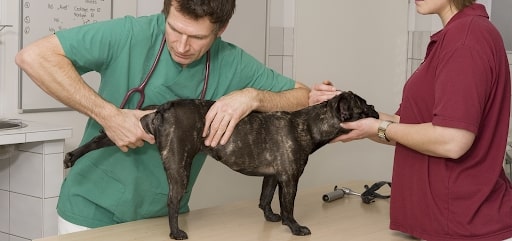
The cost range for dog hip replacement is fairly wide – and that’s because the price can be affected by various factors. These are as follows:
Type of Surgery
The cost of partial hip replacement surgery in a single hip is up to $7,000. It doubles to $14,000 when your dog needs a total hip replacement, i.e., surgery in both hips. However, the cost can be much lower or higher depending on other factors.
Surgical Facilities and Geographic Location
A high-end vet hospital with advanced facilities and services like same-day diagnosis and surgery is expensive. Plus, the cost will increase if you live in a metropolis like Manhattan or Los Angeles – or a state with a high tax rate like New York or Hawaii.
Size and Weight of the Dog
Surgery costs and pre-operative/post-operative care are higher for a large and heavy dog like Great Dane or Saint Bernard. It needs more medicine and anesthesia. Plus, rapid size growth and weight gain make the condition worse, needing expensive care.
Age of the Dog
Hip dysplasia, arthritis, injuries, etc., worsen with age and need more care and checking throughout the hip replacement surgery process. Plus, older dogs often suffer from complications like nerve damage or femoral fracture, needing additional treatment.
Pre-Surgery Testing and Preparation
Before the surgery, hip X-rays detect joint or bone issues, nerve diseases, bone size, etc. Pre-operative radiographs may be used for other conditions, too. Plus, pre-surgical blood work, clotting tests, electrocardiograms, and other tests are further required.
Hospital Stay and Post-Surgery Care
After the surgery, your dog may need hospital care for 1-7 days. However, surgical complications can extend hospital care. Plus, post-operative care needs tests, pain management medication, which can be a life-long requirement and rehabilitation.
Related: Canine Care: Breaking Down the CT Scan Dog Cost
Average Cost of Dog Hip Replacement Surgery
Factors like the dog’s health, surgery location, and pre- and post-op testing and care affect hip replacement surgery costs. Most pet owners bear an average cost of about $6,000 for partial hip replacement and $12,000 for total hip replacement surgery.
However, the cost range can vary between $3,500 and $7,000 for each hip, increasing the cost to $7,000-$14,000 for both hips. However, when you get the base quote, you must determine what is included in the package to determine the additional expenses.
Related: Dog Slipped Disc Surgery Cost – Full Guide
Cost Breakdown of Dog Hip Replacement Surgery
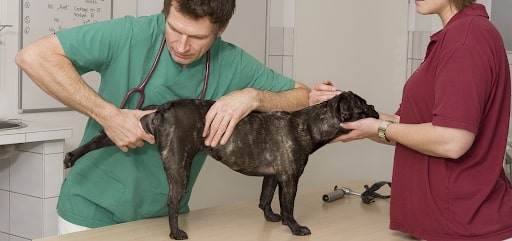
The hip replacement surgery package usually includes the following:
- Hip implants
- Pre-surgery blood work
- Pre-surgery X-ray
- Hospitalization
- Antibiotics
- Analgesics
- Surgical fee
- Surgical drapes
There are other costs involved with the overall hip replacement. These include the initial consultation, post-surgical screening and follow-ups, physical therapy, and pain management. Plus, some surgical packages don’t include X-rays and anesthesia.
Here are some other expenses you may have to bear:
| Initial consultation | $50-150 |
| X-ray | $60-180 |
| Additional hip screening | $200 |
| Anesthesia | $50-200 |
| Post-surgery evaluation | $200-300 |
| Post-op follow-up and physical therapy | $1,000 |
| Pain management medication | $50-100 |
Related: Luxated Patella of Dog – Surgery Cost
Ways to Reduce the Cost of Dog Hip Replacement Surgery
Clearly, hip replacement can be an expensive affair. However, there are ways to reduce the cost. Here’s how to do it:
Consider Pet Insurance and Care Credit Card
Pet insurance is a helpful way to reduce the cost of pet medical care. And that includes hip replacement surgery. Also, consider using pet care credit cards for upfront expenses. Later you can use the insurance money to clear the credit card balance.
Look for Funding Programs for Dogs
Organizations like My Pet Child, Companions in Crisis, Red Rover, The Pet Fund, Dylan’s Heart, etc., help pay vet bills. You may further resort to crowdfunding channels like Go Fund Me, Waggle, FundRazr, etc., or request help from religious institutions.
Find Financing Options
Another great way to avoid paying the entire expense of a dog hip surgery out of your pockets is a loan. For pet financing options, you can contact banks, credit unions, and other lenders. You may also request your employer for a loan to cover the expense.
Research Low-Cost Veterinary Clinics
If the surgery cost is too high, you can look for local clinics with budget-friendly packages. A specialized hospital may be expensive if your dog needs prolonged care. Also, find a clinic that accepts financing options, insurance, and care credit.
Discuss Options with Your Doctor
Ask your doctor about low-cost surgical and treatment packages. In addition, ask your doctor if a hip replacement is your dog’s only course of treatment. Double or Triple Pelvic Osteotomy and Femoral Head Ostectomy are low-cost hip surgery options.
Related: TPLO Surgery for Dog Cost
Dog Hip Replacement Surgery – Procedure and Recovery

Limping, movement problems, fatigue, etc., are obvious indicators of conditions that may need a hip replacement. To qualify for the surgery, a dog must be skeletally mature by 9-12 months of age. It must also weigh 40 lb or more.
There is no upper age limit to quality as a good candidate for hip replacement. But pet owners often wonder if an old dog would be ideal to undergo this complicated and expensive surgery.
However, conditions that can only be fixed with partial or total hip replacement surgery usually occur when the dog is old. So depriving a dog of surgery when the doctor recommends it might lead to pain, discomfort, and immobility.
A dog must also be in good health to qualify for hip replacement. It should have no other health or organ conditions, nerve diseases, or bone and joint diseases. Don’t forget that an arthritic dog without any pain, discomfort or mobility issues can’t have this surgery.
How is Hip Replacement Surgery for Dogs Performed?
Your dog’s hip has a ball and socket joint. The socket in the pelvis covers the ball on top of the femur. Hip replacement surgery removes this entire part in one or both hips. It is replaced with prosthetic implants.
The ball is usually made of cobalt-chromium alloy in a canine hip replacement. On the other hand, the socket is made of high molecular weight polyethylene plastic. The implants are generally held in place with the help of specialized bone cementing.
Here’s a video that describes a dog hip replacement surgery.
Why is Hip Replacement Surgery for Dogs Required
Hip replacement surgery is required when your dog has severe hip dysplasia or arthritis. It may also be required if the hip is broken beyond repair. If left untreated, these conditions can cause pain and discomfort, lameness, and impaired limb functions.
Hip replacement surgery can prevent conditions like muscle wasting (atrophy) or degenerative joint disease (osteoarthritis). Other conditions dogs with hip problems have to live with include damaged muscles, nerves, ligaments, etc.
About 95% of dogs undergoing hip replacement surgery regain normal functions and enjoy pain-free activities without limping. It helps a dog return to its regular activity levels by improving hip motion and increasing muscle mass.
Hip problems are not life-threatening; a dog can live its entire life with them. However, such conditions can affect their quality of life and personality. Hip problems should ideally be managed with hip replacement – or other surgeries like DPO/TPO and FHO.
Expected Recovery and Rehabilitation After Dog Hip Replacement Surgery
The sutures of the surgery are usually removed within 10-14 days. During this time, your dog will need to be monitored closely. And you can expect a recovery time of 1-3 months after THR surgery. Post-operative care is important. It includes the following:
- The surgery site must be monitored for redness, inflammation, or discharge.
- A cone collar can prevent the dog from licking and pawing the incision.
- Administer the medications as prescribed. Refrain from giving OTC drugs.
- Take your dog for regular check-ups and tests after the surgery.
- For the first month, your dog’s activity level should be restricted.
- Limit outdoor activities to prevent infections and dirt exposure.
- Ensure that the dog is in a safe environment away from stairs, kids, or other pets.
- Keep the dog in a quiet place to be comfortable and well-rested.
- Start taking your dog on long walks during the second month after surgery.
- After the second month, initiate regular exercises to restore limb activities.
Related: Dog ACL Surgery Cost and Treatment
Dog Hip Replacement Cost: FAQs
Q: What Is the Dog Hip Dysplasia Surgery Success Rate?
A: The dog hip dysplasia surgery success rate is 90-98%. And around 95% of dogs regain the normal functions of their limbs after this surgery. They can enjoy a completely pain-free life. In the long run, such dogs either experience no limping or mild lameness in the worst cases.
Q: What Is the Average Dog Hip Replacement Recovery Time?
A: The average dog hip replacement recovery time is 6-12 weeks. This includes the time the dog requires to regain movement of the operated leg and full strength of the joint and muscles. They usually start moving their legs the same day as the surgery and start walking within a few weeks.
Q: Is My Dog Too Old for Hip Replacement?
A: No, your dog is never too old for a hip replacement procedure. There is no upper limit on the age at which a dog can get its hip replacement, and this surgery can improve the quality of life of even senior dogs, which they deserve. But surgical complications, and other health problems of the dog must be considered.
Q: How Long Can a Dog Live with Hip Problems?
A: A dog can live its full life with hip problems. The number of years depends on the average lifespan of the species. But hip problems do not hamper the dog’s life; if it gets treatment, it will have a high quality of life. But without treatment, it will experience pain, degeneration of bones, mobility, issues, etc.
Q: What Happens if Hip Dysplasia Is Left Untreated in Dogs?
A: If hip dysplasia is left untreated in dogs, the condition can deteriorate and lead to osteoporosis, a degenerative joint disease, along with muscle wasting or atrophy. Such dogs experience pain and lameness in the hind legs and may eventually have trouble moving.
Dog Hip Replacement Surgery – To Give Your Pet An Active Life Again

Hip problems are quite common among dogs. And sometimes, hip replacement might be an expensive but mandatory solution. Depriving your dog of the surgery can reduce your fur baby’s quality of life.
So research the affordable ways to get this treatment with your pet. And don’t shy away from discussing the suitable options with your vet, finance companies, and pet care organizations.

